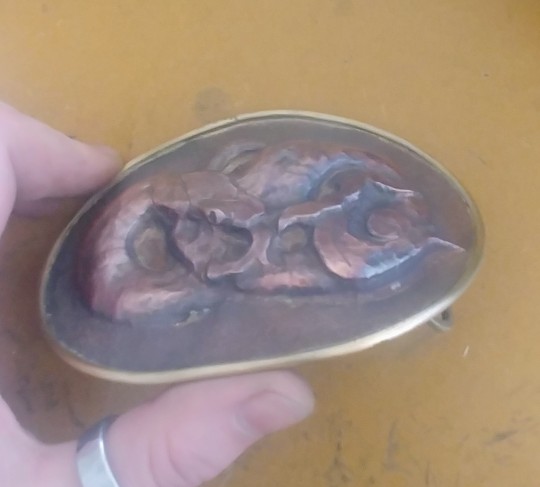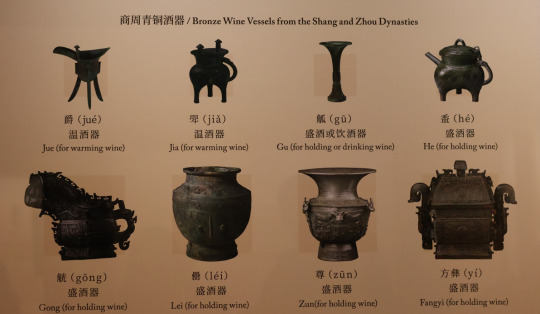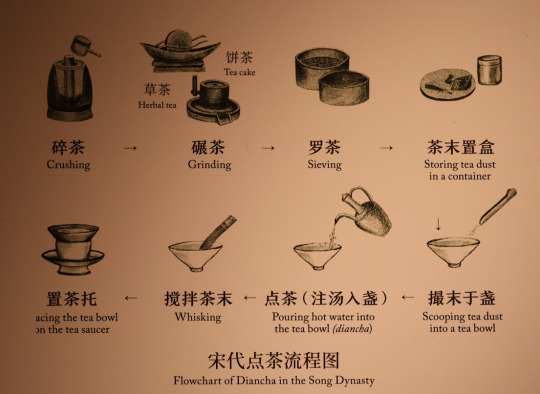#chasing and repoussé snake!
Explore tagged Tumblr posts
Text


2 notes
·
View notes
Text
April 20, Beijing, China, National Museum of China/中国国家博物馆 (Part 7 – Ancient Chinese Food Culture exhibition/中国古代饮食文化展):
Happy Chinese New Year and Lunar New Year to everyone in advance! Wishing everyone success in the Year of the Snake! 祝大家蛇年吉祥,万事如意!
CNY and LNY traditions vary by region, but the one thing that is definitely shared by everyone is that there's bound to be a family feast on the Eve (which for this year will be the 28th of January), so today's post will be quite fitting. Let us begin with alcohol-related artifacts:
The Alcohol (酒/jiǔ)*:
Liao dynasty (916 - 1125) gold wine vessel, where this type of vessel is named zhihu/执壶. Typically when you see similarly shaped vessels in Chinese period dramas, wuxia or xianxia shows, or animated shows, regardless of the material, it's always a wine vessel. The detailed low relief motifs of bird and flowers was crafted using repoussé and chasing techniques, together called zanke/錾刻 in Chinese:

*Note: although in this post I will be alternating between using "wine" and "alcohol" as the translation for jiu/酒, jiu can refer to all types of alcoholic drinks, and usually a descriptor will be added before jiu to create a new word for a specific type of alcoholic beverage. For example, wine would be called putaojiu/葡萄酒 in Chinese (lit. "grape alcohol"), and cocktails would be called jiweijiu/鸡尾酒 in Chinese (lit. "cocktail alcohol"). The names of traditional Chinese alcohols are descriptive in other ways, for example baijiu/白酒 (lit. "white alcohol"; actually it's colorless) and huangjiu/黄酒 (lit. "yellow alcohol"). Beer is called pijiu/啤酒 (lit. "beer alcohol") in Chinese, where pi/啤 is a homophonic translation of the English word beer.
Liao dynasty gold wine cups decorated with gold filigree, depicting clouds and birds:

Liao dynasty gold wine jug with a short spout in the shape of a beast head. The overall shape with flat ridges arranged vertically all around the vessel is called gualeng/瓜棱 (lit. "melon ridges"), so named because it resembles the shape of a ribbed melon.

China has a long history of making and drinking alcohol, which started at around 7000 BC. In the very beginning, alcohol was only produced in small amounts, so its use was reserved for ceremonies and celebrations. From roughly Han dynasty (202 BC - 220 AD) to Northern Song dynasty (960 - 1127) was the time period during which traditional Chinese alcohol making had matured. The famous Tang-era (618 - 907 AD) drunk poet Li Bai/李白 lived during this period of time.
Warring States period (476 - 221 BC) bronze wine jug inlaid with gold and silver:

Qing dynasty (1644 - 1911) enamel wine cups:

Beishan Jiujing/《北山酒经》 or "The Classic of Wine" by Zhu Yizhong/朱翼中 of Northern Song dynasty. This book covered the history of alcohol in China, and described alcohol making methods of the time, specifically the methods used to produce alcohol on a large scale.

8 Types of bronze wine vessels from Shang (·1600 - 1046 BC) and Zhou dynasties (1046 - 256 BC):

The Tea (茶/chá):
China also has a long history of growing and drinking tea, being the country where the beverage originated from. Specifically, tea drinking first started in what is now Yunnan province, developed into a culture in Sichuan, then spread to all of China and beyond.
Qing dynasty duck-shaped tin teapot:

Qing dynasty Qianlong era (1736 - 1796) lacquered teacup, decorated with a poem by the Qianlong Emperor, the same poem as the jade gaiwan/盖碗 from the jade exhibition. The technique of decorating here is called diaoqi/雕漆, where different colored lacquer were layered onto the object, and then patterns would be carved into the thick lacquer, revealing the layers of colors.

A flowchart of the tea preparing and making process in Song dynasty (960 - 1276), called diancha/点茶, which influenced Japanese tea culture. Because of the complexity of the diancha process, it was abandoned in Ming dynasty (1368 - 1644) in favor of simply steeping tea leaves in water.

A video showing the Song-era diancha tea making process. This exact video also plays in the exhibition:
youtube
The Food (食/shí):
A Western Han dynasty (202 BC - 8 AD) small bronze hot pot, called a ranlu/染炉. Contrary to the modern Chinese hot pot where food cooked by boiling would be dipped in a bowl of room temperature condiments before eating, during Han dynasty people liked hot condiments, so this small hot pot was actually specifically for heating the condiments as people ate.

Various lacquered food containers from different dynasties.
Left: Western Han dynasty lacquered food container replica; when the original artifact was unearthed, it contained what seemed to be flatbread.
Middle: Ming dynasty 5-layered stacked lacquered food containers, held together with buttons, and decorated with diaoqi technique.
Right: Qing dynasty begonia-shaped lacquered fruit container, also decorated with diaoqi technique.

Qing dynasty tin tripod hot pot. This is a traditional Manchu hotpot, and its structure is quite similar to the classic Beijing style copper hotpot (I couldn't find anything that confirms a connection between the two, however). Both have a central chamber in the middle for charcoal (heat source), and the cooking is done in the heated water around the central chamber. The two biggest differences are the presence/absence of the tall "chimney" structure above the central chamber, and the material used. The reason this hotpot is tin may be because copper was mostly used to mint coins during Qing dynasty.

These two books were actually on display over at the Science and Technology exhibition, but I moved them here because that post was getting a bit too long. Since both books are about agriculture, they fit into this post quite well. The book on the left is Qimin Yaoshu/《齐民要术》 by Jia Sixie/贾思勰 in Northern Wei dynasty (386 - 534 AD), translated as either "Essential Techniques for the Welfare of the People" (the more accurate translation imho) or "Essential Techniques for the Peasantry". It is an encyclopedia on a wide range of agricultural and food processing techniques. The book on the right is Nongzheng Quanshu/《农政全书》 by Xu Guangqi/徐光启 in Ming dynasty, translated as "Complete Treatise on Agricultural Administration". This book is also an encyclopedia that covers agricultural techniques, but also has long sections covering what to do in response to floods and famines.

Pretty interesting and self-explanatory chart on when some crops, vegetables, and fruits were introduced to China (arranged in chronological order). As one can see here, Chinese cuisine had changed a lot over the past ~3000 years, and much of the changes took place during periods when trading activities increased and new produce were introduced. The best example of this is the introduction of hot chilis in late Ming dynasty, which directly resulted in the famous mala/麻辣 flavor profile of Sichuan cuisine and heavily influenced many other Chinese regional cuisines (Hunan cuisine, Guizhou cuisine, Anhui cuisine, etc).

A diagram explaining the seating arrangement in a palace's main hall in ancient times (top half), and the seating arrangement around a table in Southern and Northern China (bottom half). In all of these cases, the seat facing south (which also faces the entrance in traditional halls) is always reserved for the person of highest status, kind of like the seat at the head of the table. For the bottom half, the numbering indicates the order of seniority and/or inferiority (1 is the highest status).

Some examples of famous dishes from different dynasties, these are arranged in chronological order if going top to bottom, left to right:

Finally, some bonus pictures to serve as the conclusion to my brief trip to Beijing. This oil painting of the Great Wall was in the lobby of the museum, I thought it was pretty neat.

A peek at the Zhengyangmen/正阳门 gatehouse. Zhengyangmen is the southern gate (front gate) to the inner city in imperial times, today it's the only gate of the inner city that still stands.

A closeup of the Zhengyangmen gatehouse. I think the caihua/彩画 (the colorful painting on the building; also called caihui/彩绘) here had some restoration work done on it in recent years? It looks a lot more vibrant than the caihua on other historic architecture.

This is the last museum post (long post) of the 2024 China series (PHEW), and the final posts will all be fairly short, most of them about the food I've had. See y'all after CNY/LNY!
#2024 china#beijing#china#national museum of china#chinese cuisine#chinese history#chinese food#chinese culture#chinese architecture#chinese tea ceremony#chinese table etiquette#cuisine#food#alcohol#wine#tea#hot pot#history#culture#etiquette#architecture#Youtube
55 notes
·
View notes
Text
Exploring the Craftsmanship of 19th Century Gold Jewelry
The 19th century was a period of remarkable innovation and artistry in gold jewelry design. This era, which spans the Victorian and Romantic periods, saw goldsmiths elevate their craft to new heights, blending traditional techniques with fresh, intricate designs. Let’s delve into the masterful craftsmanship that defines this century's gold vintage jewelry.
1. Handcrafted Excellence
Unlike modern mass production, 19th-century gold jewelry was predominantly handcrafted. Artisans meticulously shaped gold using age-old techniques like chasing, engraving, and repoussé, creating detailed textures and patterns. Each piece, whether a locket or a brooch, bore the personal touch of the jeweler, showcasing their skill in manipulating gold.
2. Etruscan Revival
During this time, there was a fascination with ancient civilizations, particularly the Etruscans. Jewelers mimicked the granulation techniques of Etruscan goldsmiths, adding tiny gold beads and filigree to designs. The Etruscan Revival style emerged, characterized by intricate patterns and bold, geometric shapes that were both ornamental and symbolic.
3. Romantic and Symbolic Designs
Gold jewelry from the early 19th century often featured romantic themes and symbolism. Hearts, snakes (representing eternal love), and floral motifs were prevalent. Gold lockets, a staple of the period, often held portraits or locks of hair, becoming sentimental keepsakes. This personalization made each piece unique and deeply cherished.
4. High Karat Gold
Jewelry from the 19th century typically used high karat gold—often 18k to 22k—which was softer and more malleable, allowing for intricate designs. The high gold content gave pieces a rich, warm hue that distinguished them from later jewelry trends. The craftsmanship involved was delicate, as working with such fine gold required a keen understanding of metalworking.
5. Gold Leaf and Engraving Techniques
Another popular method was the use of gold leaf and delicate engraving, particularly on lockets, brooches, and rings. Jewelers used hand tools to carve intricate designs into the surface of the gold, often featuring natural elements like vines, leaves, and birds. These finely engraved details were a testament to the artist’s patience and precision.

1 note
·
View note
Photo

I thought I’d bring this little guy back from then the archives. I’m thinking of starting a high karat gold ancient collection revival. It’s long sold but like all my work, it was entirely hand fabricated (no casting) using only but a few basic (non electric) tools. Snake head was made using chasing & repoussé. https://www.instagram.com/p/Bu4pNfUgyM-/?utm_source=ig_tumblr_share&igshid=370gi41rm7i6
2 notes
·
View notes
Photo

Art of the Day: Gold Disk A round sheet worked in repoussé with some surface chasing. The central boss is surrounded by eight creatures: lion, deer, scorpion, human figure (?), genitalia (?), lizard (?), bird (?), snake (?). Two circles of dots worked from the back surround the animals. The disk is edged with twisted wire. On the back, a metal strip forms a loop for threading onto a chain. Learn more about this object in our art site: http://bit.ly/2tVdcJP
4 notes
·
View notes